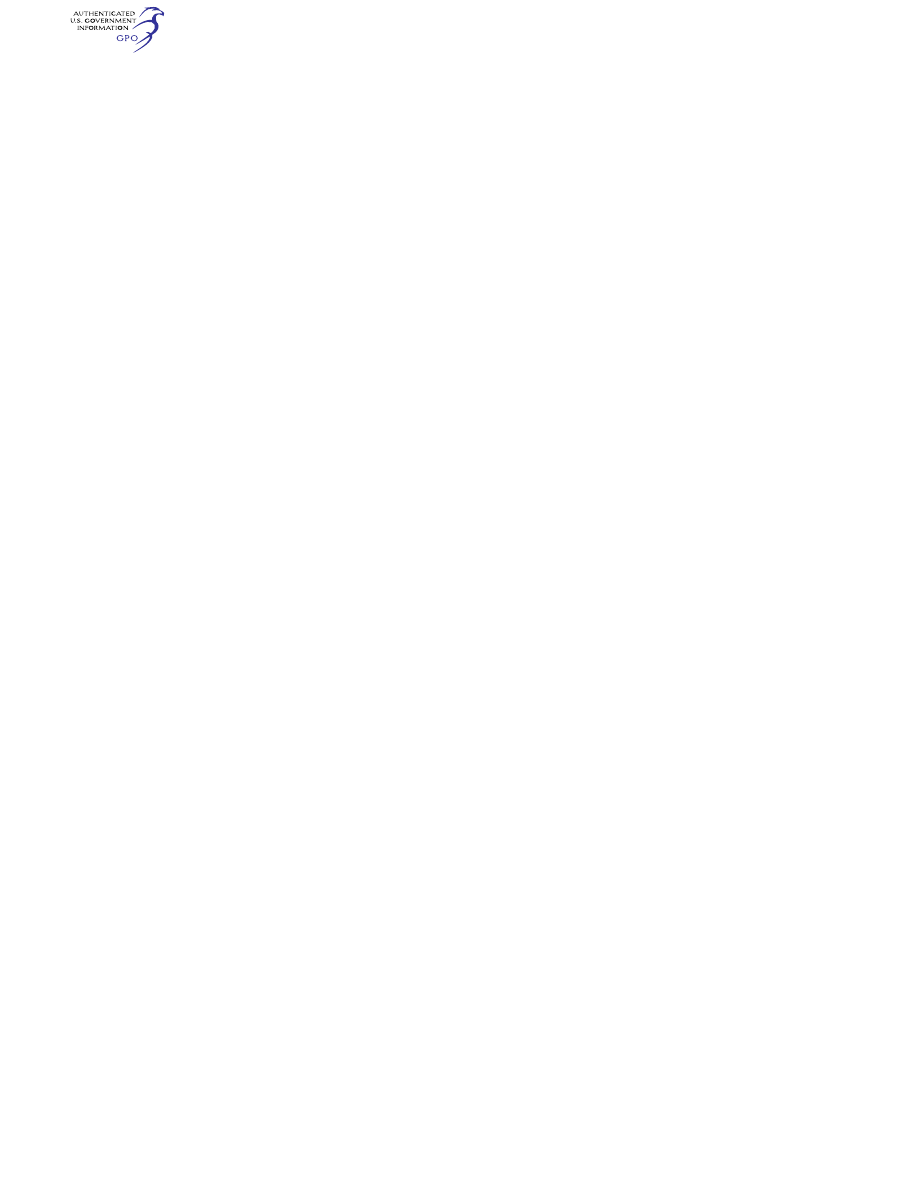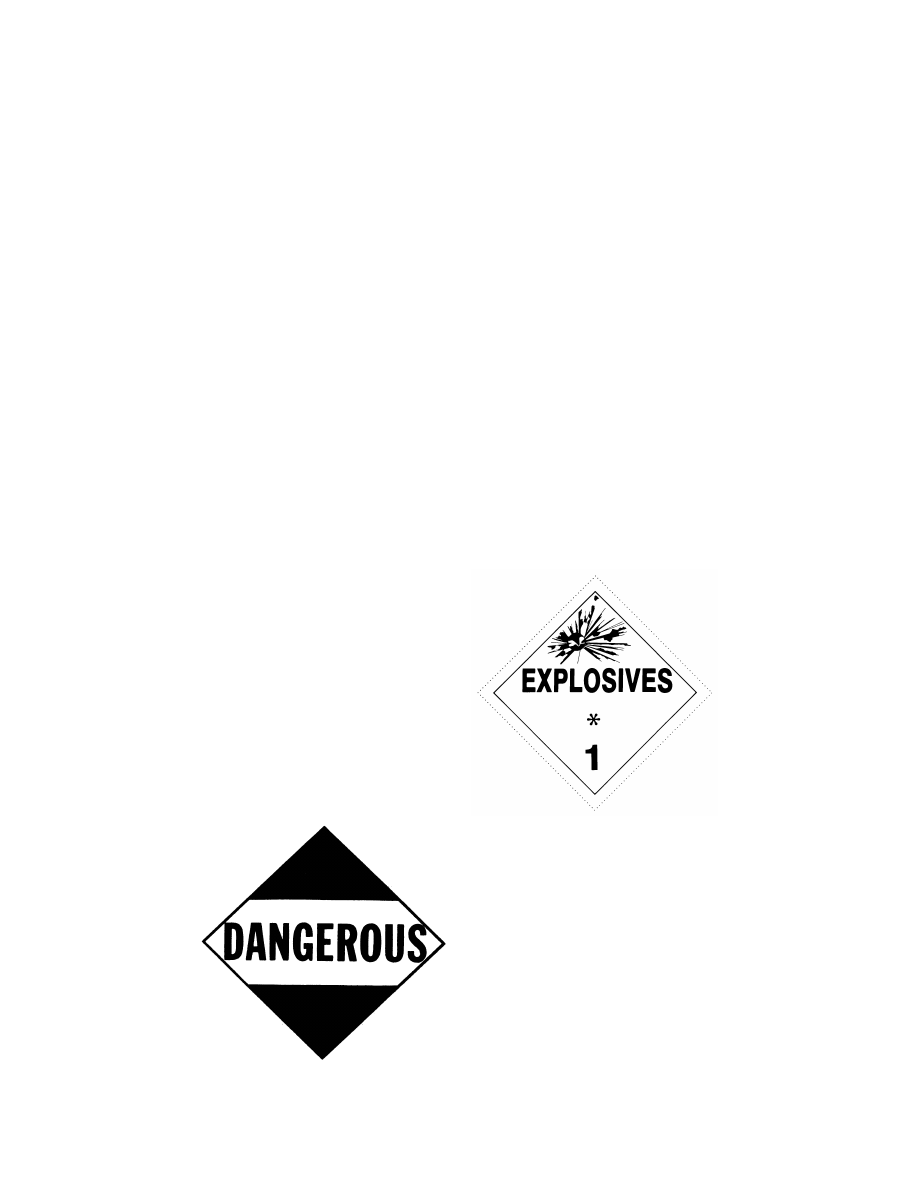
441
Pipeline and Haz. Matls. Safety Admin., DOT
§ 172.519
and conforms to § 173.29(b)(1) of this
subchapter.
(c)
Exceptions.
The following pack-
agings may be placarded on only two
opposite sides or, alternatively, may be
labeled instead of placarded in accord-
ance with subpart E of this part:
(1) A portable tank having a capacity
of less than 3,785 L (1000 gallons);
(2) A DOT 106 or 110 multi-unit tank
car tank;
(3) A bulk packaging other than a
portable tank, cargo tank, flexible
bulk container, or tank car (
e.g.,
a bulk
bag or box) with a volumetric capacity
of less than 18 cubic meters (640 cubic
feet);
(4)
An IBC.
For an IBC labeled in ac-
cordance with subpart E of this part,
the IBC may display the proper ship-
ping name and UN identification num-
ber markings in accordance with
§ 172.301(a)(1) in place of the UN number
on an orange panel, placard or white
square-on-point configuration as pre-
scribed in § 172.336(d); and
(5) A Large Packaging as defined in
§ 171.8 of this subchapter.
(d) A flexible bulk container may be
placarded in two opposing positions.
[Amdt. 172–136, 59 FR 38064, July 26, 1994;
Amdt. 172–148, 61 FR 50255, Sept. 25, 1996, as
amended by 66 FR 45379, Aug. 28, 2001; 69 FR
64473, Nov. 4, 2004; 75 FR 5392, Feb. 2, 2010; 76
FR 43528, July 20, 2011; 77 FR 60942, Oct. 5,
2012; 81 FR 35540, June 2, 2016; 85 FR 27878,
May 11, 2020]
§ 172.516
Visibility and display of plac-
ards.
(a) Each placard on a motor vehicle
and each placard on a rail car must be
clearly visible from the direction it
faces, except from the direction of an-
other transport vehicle or rail car to
which the motor vehicle or rail car is
coupled. This requirement may be met
by the placards displayed on the
freight containers or portable tanks
loaded on a motor vehicle or rail car.
(b) The required placarding of the
front of a motor vehicle may be on the
front of a truck-tractor instead of or in
addition to the placarding on the front
of the cargo body to which a truck-
tractor is attached.
(c) Each placard on a transport vehi-
cle, bulk packaging, freight container
or aircraft unit load device must—
(1) Be securely attached or affixed
thereto or placed in a holder thereon.
(See appendix C to this part.);
(2) Be located clear of appurtenances
and devices such as ladders, pipes,
doors, and tarpaulins;
(3) So far as practicable, be located so
that dirt or water is not directed to it
from the wheels of the transport vehi-
cle;
(4) Be located away from any mark-
ing (such as advertising) that could
substantially reduce its effectiveness,
and in any case at least 3 inches (76.0
mm.) away from such marking;
(5) Have the words or identification
number (when authorized) printed on it
displayed horizontally, reading from
left to right;
(6) Be maintained by the carrier in a
condition so that the format, leg-
ibility, color, and visibility of the
placard will not be substantially re-
duced due to damage, deterioration, or
obscurement by dirt or other matter;
(7) Be affixed to a background of con-
trasting color, or must have a dotted
or solid line outer border which con-
trasts with the background color.
(d) Recommended specifications for a
placard holder are set forth in appendix
C of this part. Except for a placard
holder similar to that contained in ap-
pendix C to this part, the means used
to attach a placard may not obscure
any part of its surface other than the
borders.
(e) A placard or placard holder may
be hinged provided the required format,
color, and legibility of the placard are
maintained.
[Amdt. 172–29, 41 FR 15996, Apr. 15, 1976, as
amended by Amdt. 172–101, 45 FR 74668, Nov.
10, 1980; Amdt. 172–123, 55 FR 52601, Dec. 21,
1990; 65 FR 50460, Aug. 18, 2000]
§ 172.519
General specifications for
placards.
(a)
Strength and durability.
Placards
must conform to the following:
(1) A placard may be made of any
plastic, metal or other material capa-
ble of withstanding, without deteriora-
tion or a substantial reduction in effec-
tiveness, a 30-day exposure to open
weather conditions.
(2) A placard made of tagboard must
be at least equal to that designated

442
49 CFR Ch. I (10–1–23 Edition)
§ 172.519
commercially as white tagboard. Tag-
board must have a weight of at least 80
kg (176 pounds) per ream of 610 by 910
mm (24 by 36-inch) sheets, water-
proofing materials included. In addi-
tion, each placard made of tagboard
must be able to pass a 414 kPa (60 p.s.i.)
Mullen test.
(3) Reflective or retroreflective mate-
rials may be used on a placard if the
prescribed colors, strength and dura-
bility are maintained.
(b)
Design.
(1) Except as provided in
§ 172.332 of this part, each placard must
be as described in this subpart, and ex-
cept for size and color, the printing,
inner border and symbol must be as
shown in §§ 172.521 through 172.560 of
this subpart, as appropriate.
(2) The dotted line border shown on
each placard is not part of the placard
specification. However, a dotted or
solid line outer border may be used
when needed to indicate the full size of
a placard that is part of a larger for-
mat or is on a background of a non-
contrasting color.
(3) For other than Class 7 or the
DANGEROUS placard, text indicating
a hazard (for example, ‘‘FLAM-
MABLE’’) is not required. Text may be
omitted from the OXYGEN placard
only if the specific identification num-
ber is displayed on the placard.
(4) For a placard corresponding to the
primary or subsidiary hazard class of a
material, the hazard class or division
number must be displayed in the lower
corner of the placard. However, a per-
manently affixed subsidiary placard
meeting the specifications of this sec-
tion which were in effect on October 1,
2001, (such as, a placard without the
hazard class or division number dis-
played in the lower corner of the
placard) and which was installed prior
to September 30, 2001, may continue to
be used as a subsidiary placard in do-
mestic transportation by rail or high-
way, provided the color tolerances are
maintained and are in accordance with
the display requirements in this sub-
chapter.
(c)
Size.
(1) Each diamond (square-on-
point) placard prescribed in this sub-
part must measure at least 250 mm
(9.84 inches) on each side and must
have a solid line inner border approxi-
mately 12.5 mm inside and parallel to
the edge. The 12.5 mm measurement is
from the outside edge of the placard to
the outside of the solid line forming
the inner border. For domestic trans-
portation, a placard manufactured
prior to January 1, 2017, in conform-
ance with the requirements of this
paragraph in effect on December 31,
2014, may continue in service until the
end of its useful life provided the color
tolerances are maintained and are in
accordance with the display require-
ments of this subchapter.
(2) Except as otherwise provided in
this subpart, the hazard class or divi-
sion number, as appropriate, must be
shown in numerals measuring at least
41 mm (1.6 inches) in height.
(3) Except as otherwise provided in
this subpart, when text indicating a
hazard is displayed on a placard, the
printing must be in letters measuring
at least 41 mm (1.6 inches) in height.
(d)
Color.
(1) The background color,
symbol, text, numerals and inner bor-
der on a placard must be as specified in
§§ 172.521 through 172.560 of this sub-
part, as appropriate.
(2) Black and any color on a placard
must be able to withstand, without
substantial change—
(i) A 72-hour fadeometer test (for a
description of equipment designed for
this purpose, see ASTM G 23–69 or
ASTM G 26–70); and
(ii) A 30-day exposure to open weath-
er.
(3) Upon visual examination, a color
on a placard must fall within the color
tolerances displayed on the appropriate
Hazardous Materials Label and Placard
Color Tolerance Chart (see
§ 172.407(d)(4)). As an alternative, the
PANTONE
formula guide coated/
uncoated as specified for colors in
§ 172.407(d)(5) may be used.
(4) The placard color must extend to
the inner border and may extend to the
edge of the placard in the area des-
ignated on each placard except the
color on the CORROSIVE and RADIO-
ACTIVE placards (black and yellow, re-
spectively) must extend only to the
inner border.
(e)
Form identification.
A placard may
contain form identification informa-
tion, including the name of its maker,
provided that information is printed

443
Pipeline and Haz. Matls. Safety Admin., DOT
§ 172.523
outside of the solid line inner border in
no larger than 10-point type.
(f)
Exceptions.
When hazardous mate-
rials are offered for transportation or
transported under the provisions of
subpart C of part 171 of this subchapter,
a placard conforming to the specifica-
tions in the UN Recommendations, the
ICAO Technical Instructions, the
IMDG Code, or the Transport Canada
TDG Regulations (IBR, see § 171.7 of
this subchapter) may be used in place
of a corresponding placard conforming
to the requirements of this subpart.
However, a bulk packaging, transport
vehicle, or freight container containing
a material poisonous by inhalation (see
§ 171.8 of this subchapter) must be plac-
arded in accordance with this subpart
(see § 171.23(b)(10) of this subchapter).
(g)
Trefoil symbol.
The trefoil symbol
on the RADIOACTIVE placard must
meet the appropriate specification in
appendix B of this part.
[Amdt. 172–123, 55 FR 52601, Dec. 21, 1990, as
amended at 56 FR 66260, Dec. 20, 1991; 57 FR
45460, Oct. 1, 1992; Amdt. 172–143, 60 FR 50305,
Sept. 28, 1995; 65 FR 50460, Aug. 18, 2000; 66 FR
33426, June 21, 2001; 66 FR 44255, Aug. 22, 2001;
67 FR 15743, Apr. 3, 2002; 70 FR 34075, June 13,
2005; 69 FR 64473, Nov. 4, 2004; 72 FR 25176,
May 3, 2007; 76 FR 43528, July 20, 2011; 76 FR
56314, Sept. 13, 2011; 80 FR 1151, Jan. 8, 2015;
83 FR 55807, Nov. 7, 2018; 87 FR 79774, Dec. 27,
2022]
§ 172.521
DANGEROUS placard.
(a) Except for size and color, the
DANGEROUS placard must be as fol-
lows:
(b) In addition to meeting the re-
quirements of § 172.519, and appendix B
to this part, the DANGEROUS placard
must have a red upper and lower tri-
angle. The placard center area and
1
⁄
2
-
inch (12.7 mm.) border must be white.
The inscription must be black with the
1
⁄
8
-inch (3.2 mm.) border marker in the
white area at each end of the inscrip-
tion red.
[Amdt. 172–29, 41 FR 15996, Apr. 15, 1976, as
amended by Amdt. 172–29A, 41 FR 40680, Sept.
20, 1976]
§ 172.522
EXPLOSIVES 1.1, EXPLO-
SIVES 1.2 and EXPLOSIVES 1.3
placards.
(a) Except for size and color, the EX-
PLOSIVES 1.1, EXPLOSIVES 1.2 and
EXPLOSIVES 1.3 placards must be as
follows:
(b) In addition to complying with
§ 172.519 of this subpart, the background
color on the EXPLOSIVES 1.1, EXPLO-
SIVES 1.2, and EXPLOSIVES 1.3 plac-
ards must be orange. The ‘‘*’’ shall be
replaced with the appropriate division
number and, when required, appro-
priate compatibility group letter. The
symbol, text, numerals and inner bor-
der must be black.
[Amdt. 172–123, 55 FR 52602, Dec. 21, 1990, as
amended at 56 FR 66260, Dec. 20, 1991]
§ 172.523
EXPLOSIVES 1.4 placard.
(a) Except for size and color, the EX-
PLOSIVES 1.4 placard must be as fol-
lows:


